
What if you could earn links on autopilot?
I’m talking incredibly relevant links from authoritative publications and sites?
There’s long been a misconception that if you publish content, people will link to it. But that couldn’t be further from the truth for most businesses.
Yes, you’ll find exceptions to the rule. But for most sites, adopting the principle of ‘build it and they’ll come’ (or publish it and they’ll link to it) doesn’t work.
That is, unless you launch content that’s set up in a way that’s likely to earn links without active outreach to earn them.
You see, whilst many earned links come as a result of proactive outreach, where the links come after you’ve reached out to a site or journalist to share a story or piece of content, there are other ways.
We call these statistics pages, or organic link earning assets.
They’re pages that earn links as a result of content creators (journalists and bloggers, for example) searching for stats, facts and other pieces of information to include within their own pieces of content. They find your page that’s packed full of stats they can use, then cite and link to you.
It’s not quite as easy as it sounds. To rank at the top of the SERPs when a content creator searches something like “fast fashion statistics,” you (usually) need links. But then once the page is ranking, it earns more links naturally over time, building a moat and keeping the page ranking at the top.
When we launch statistics pages as part of an SEO or link building strategy, we combine this with one or more rounds of proactive outreach. Using the stats to tell stories that the press want to link to.
We see it as a way to kickstart these pages ranking in positions where they’ll be discovered by content creators.
And in this guide, I want to share 15 examples of statistics pages that, between them, have earned more than 8,000 links from 4,300 referring domains.
Use these as inspiration for finding topics that could work for you to create a statistics page around, or speak with our team to discuss our ‘done for you statistics page’ service where we’ll ideate, create and promote an asset to kickstart its rankings and set it up for earning links on an ongoing basis.
1. Spotio’s Sales Statistics Page

The “149 Eye-Opening Sales Statistics to Consider in 2024” statistics page on from Spotio acts as a comprehensive resource of sales insights, and there’s no surprise it’s earned links from over 800 referring domains.
It compiles a wide array of current sales data across 20 categories, including inside and outside sales, prospecting, social selling, and lead nurturing.
What does stand out is that, despite earning over 800 links, it’s not necessarily ‘stand out’ in terms of the design or formatting, which should act as perfect validation that the most important thing is the content itself.
There’s no other resource out there that’s this comprehensive when it comes to sales stats, and there’s a reason it’s earned so many links.
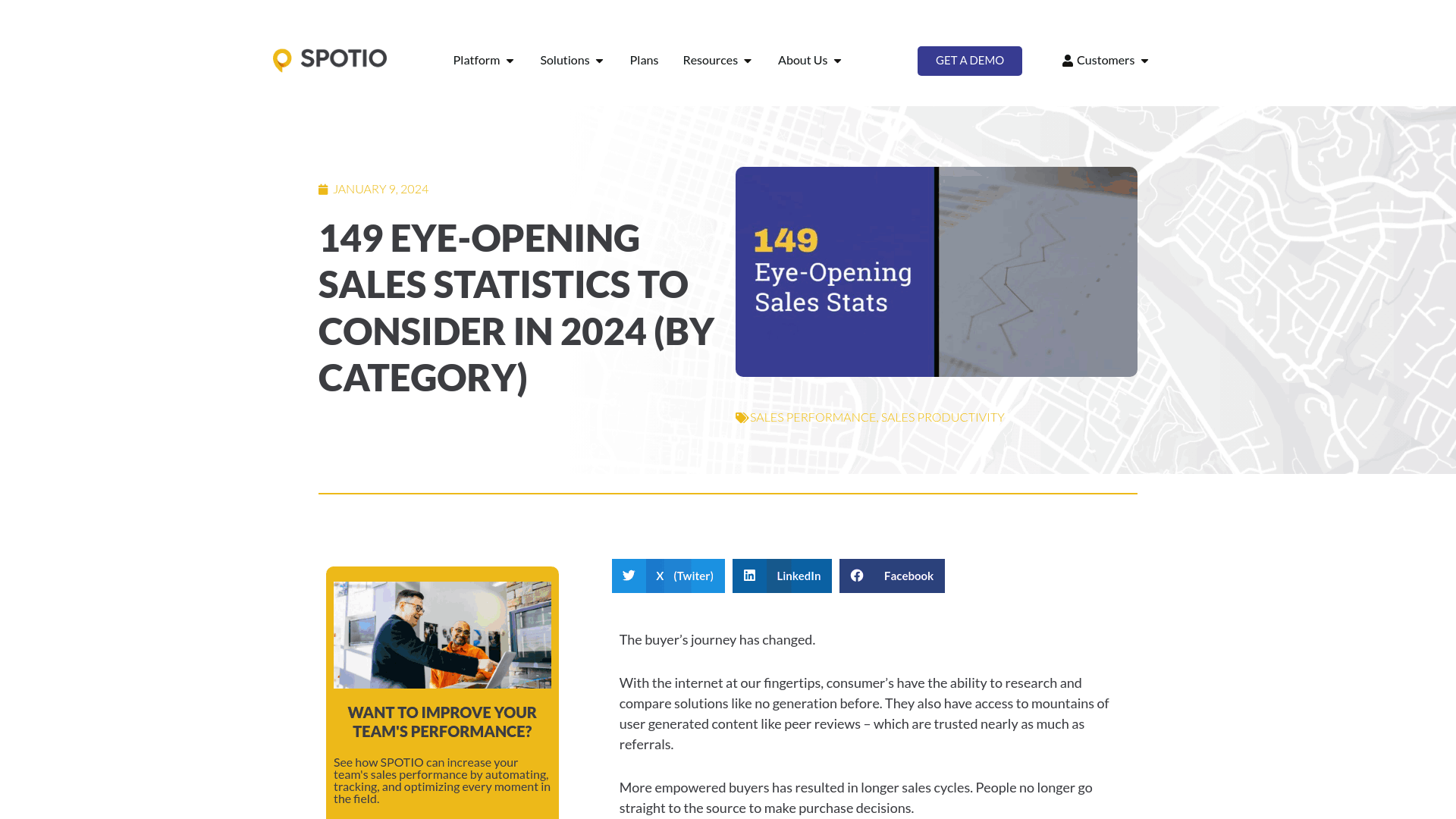
2. Siege Media’s Content Marketing Statistics Page

Siege Media’s “150 Must-Know Content Marketing Statistics for 2024” statistics page is a THE most comprehensive collection of the latest data and trends in content marketing.
And that’s without even mentioning how stunning the design is.
If you wanted one single example of best-in-class design for a stats page, it’s this.
The asset covers every aspect of content marketing and serves as a valuable reference for those looking to cite sources (or consume them) on the topic.

3. AuthorityHacker’s AI Statistics Page

Authority Hacker’s “149 AI Statistics: The Present & Future of AI at Your Fingertips” kinda bucks the trend of statistics pages, but for a good reason.
One thing you’ll notice if you take a look at this asset is that many of the statistics come from their own surveys and studies. In fact, they make this very clear at the start of the page:
Our own verified statistics from our recent AI survey and reliable third-party sources provided the foundation for this list. It covers everything from AI adoption and usage to its perceived dangers in 2024 and beyond.
The statistics you use don’t just need to come from third-party sources. And, in fact, if at all possible, you should look to work in and use your own to add additional value (in SEO, we call this information gain) that no one else has.
Combine first-party data, surveys and other research with third-party stats to ensure your page really stands out and offers something worth linking to that others don’t.

4. Uswitch’s Broadband Statistics Page

The “UK Broadband Statistics 2023” page by Uswitch offers an in-depth analysis of the UK’s broadband landscape, sharing data on average speeds, regional disparities, and user satisfaction, serving as a valuable resource for those looking to supplement their own content with these facts and stats.
And whilst links from 33 referring domains might not look at impressive as some of our other examples on first glance, what we need to consider is that this includes some ‘money couldn’t ever buy’ links from sites such as mobile network Vodafone, as well as being cited within other incredibly relevant content on the topic.
The ability to earn highly relevant links is the key with this tactic; it’s not always about the numbers.

5. Money.co.uk’s Savings Statistics Page

The “UK Savings Statistics 2024” page from Money.co.uk stands out as an excellent example of a statistics page that’s simple, yet incredibly effective, and an example of an asset that has done what it set out to; earn links by providing highly relevant and reliable data.
With detailed insights into the savings habits of UK adults, this page has become a go-to resource for journalists, bloggers, and content creators seeking to cite accurate savings data in their own work.
There’s a lot of data and stats there, but what we can also learn from this example is the importance of considering more than just ‘text on the page.’ Here, we see charts, images, data tables and more; pretty much anything that could be useful for someone wanting to find and cite these stats.

6. Condor Ferries’ Plastic In The Ocean Statistics Page

Here’s a great example of what happens when you combine an incredibly hot-topic (plastic in the ocean) with an absolute tonne of stats, data and insights.
Links from over 500 domains.
By compiling a comprehensive array of up-to-date data on oceanic plastic pollution, it serves as a valuable resource for journalists, bloggers, and researchers seeking info to add to their own content.
The page covers various aspects, including the impact on marine life, the volume of plastic waste, and projections for future pollution levels.
In many ways, it’s simple in its execution, but sometimes that’s all it needs … letting the stats and the data do what they need to do.

7. The Home Office Life’s Homeworking Statistics Page

The “Working from Home UK Statistics 2024” page on The Home Office Life serves as a comprehensive resource detailing the evolution of remote work in the UK.
Whilst there’s no first-party research or data in here, it compiles data from various studies and surveys, offering insights into trends, productivity impacts, and employee preferences regarding hybrid working models.
Again, what we can learn here is the importance of two things:
- Understanding what people actually care about on a topic. The stats you use and sub-topics you cover matter a lot.
- Knowing that trending or hot topics can act as a cheat code here, especially if you get in early whilst the topics are on the rise.

8. Finder’s First Time Buyer Statistics Page

The “First-time Buyer Statistics UK: 2024” stats page by Finder is a great example of how niche-specific statistics pages can earn relevant links while providing valuable insights. It focuses on a topic with widespread appeal and high search demand—buying your first home—which naturally attracts interest from journalists, bloggers, and content creators.
In many ways, it’s an evergreen topic; yet one where data changes frequently.
What makes this asset effective as a link-earning page is its combination of granular, up-to-date data and its focus on key concerns like average deposit sizes, regional price disparities, and buyer demographics. These details ensure it’s a go-to resource for anyone covering first-time buyer challenges in the media.
Its strength lies in the content-first approach— as with a few of my other examples, it’s not about flashy design but about being the most reliable and comprehensive resource available for first-time buyer stats. By presenting well-structured, research-backed data, this page has positioned itself as an authoritative source that others link to when discussing homeownership trends.
The takeaway here is clear: creating a highly targeted statistics page around a specific and relevant topic, like first-time buyers, can generate significant organic links, especially when the content is useful, well-cited, and widely applicable.
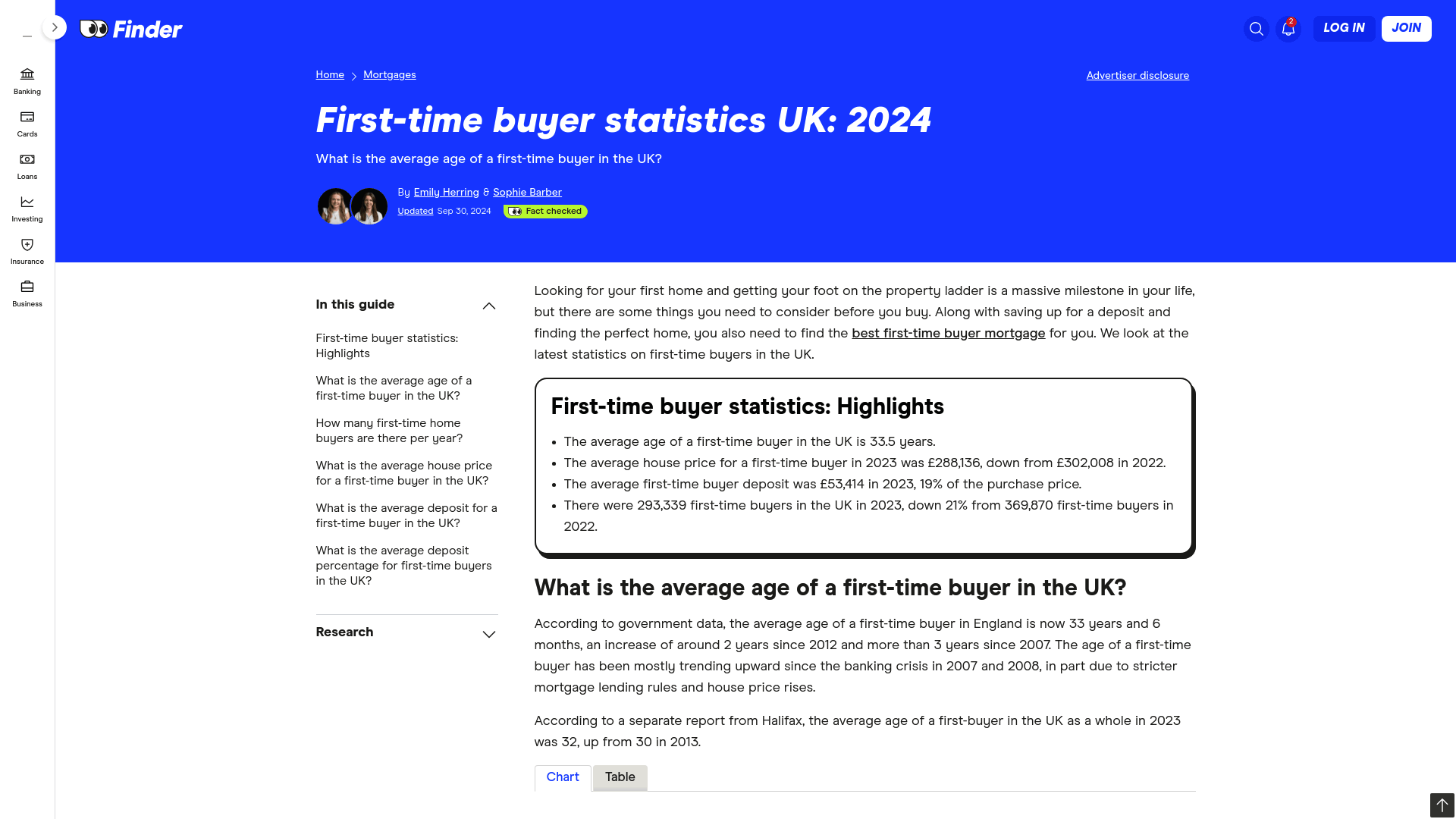
9. Fashion United’s Global Fashion Industry Statistics Page

The “Global Fashion Industry Statistics” page by FashionUnited is another awesome example of how industry-focused statistics pages can operate as natural link earning assets. Covering everything from market size and growth rates to key regional trends, it taps into a topic of constant media interest and search demand.
Often, content creators search broadly. They’ll search ‘fashion industry statistics’ rather than something more specific. They’ll know they want stats to support a story, but often not exactly what that is until they find what’s out there.
This page’s success as a link-earning asset lies in its broad appeal across multiple audiences, including journalists, analysts, and businesses in fashion and retail. By compiling reliable, frequently updated, and highly relevant statistics, it ensures that content creators find exactly what they need to support their own articles and reports.
It also benefits from its alignment with evergreen interest areas—the fashion industry’s size and trends are topics that consistently generate coverage.
The lesson here is clear: if you can create a statistics page that combines relevance, authority, and usability, it will earn links over time as a trusted resource. FashionUnited’s approach shows how this tactic works even in competitive spaces like fashion.

10. Livestrong’s Running Statistics Page

The “126 Running Statistics You Need to Know” page by Livestrong is another example of how a stats page that’s focused on a popular, evergreen AND highly searchable topic—running—it appeals to a wide audience, including journalists, fitness bloggers, and health enthusiasts, all of whom rely on credible data for their own content.
Another key reason for the page’s ongoing success is its evergreen nature.
We’re seeing a recurring theme here, aren’t we?
Running is a topic that consistently generates interest and coverage, making this page a long-term asset for earning links. In many ways this is key; to earn links over time, there’s got to be ongoing interest.
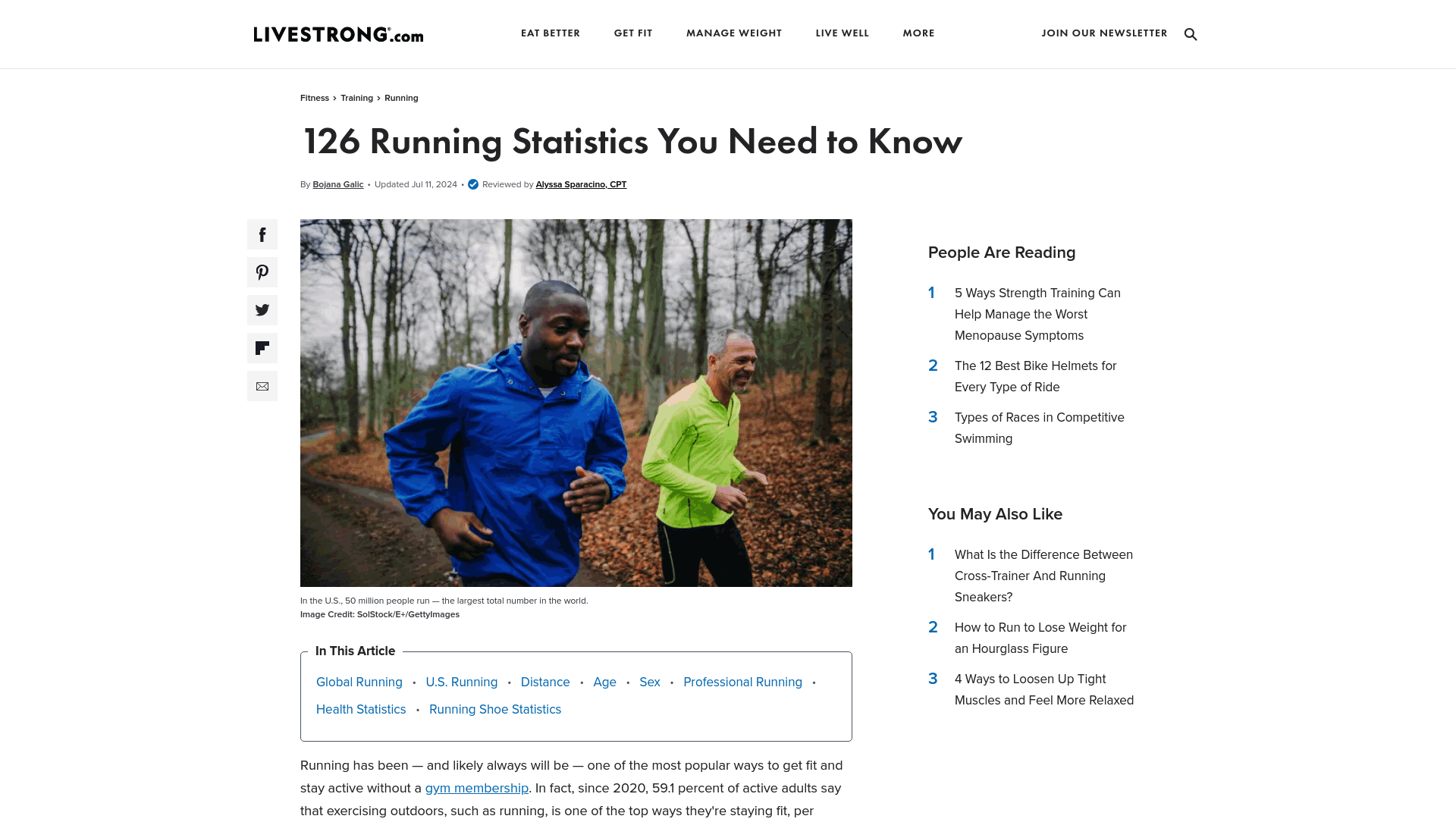
11. Nescafe’s Coffee Statistics Page

The “20 Coffee Statistics That’ll Blow Your Mind” page by NESCAFÉ® is another great example of how a branded statistics page can support organic link-building while showcasing authority in a specific niche.
And, of course, showcasing authority often earns relevant links which, in turn, further increase authority in a niche.
By covering a universally appealing topic—coffee—it naturally attracts links from journalists, bloggers, and content creators writing about everything from coffee culture to market trends.
This isn’t an asset that earned links overnight, though. Far from it.

Since being launched in mid 2003, it’s been slow and steady link acquisition. But I’d put a massive bet on this being without any proactive outreach or promotion.
What sets this page apart as a link-earning asset against some others is its clever blend of data and simplicity.
It’s not text heavy, at all. In fact, it’s by far the most simplistic of all of the stats page examples I’m giving here.
But this approach highlights a key principle: the data itself must be engaging and useful, especially for content creators looking to provide credible sources in their own work.
There’s a major lesson here, though: create statistics pages around topics you have authority in, but make them engaging, accessible, and relevant to content creators.
Don’t create these pages around topics you don’t have any authority in; they’ll struggle to rank, for starters, and the links they earn won’t be as impactful.

12. FinancesOnline’s IT Statistics Page

The “50 Crucial IT Statistics You Must Know: 2024 Data Analysis & Market Share” page by FinancesOnline is a textbook example of a statistics page built to earn links over time. Covering a topic with wide appeal—technology trends and market data—it attracts attention from tech writers, industry professionals, and content creators needing reliable and comprehensive sources.
It’s another that’s simple but effective, and another great example of using charts and visuals in a smart way that enhance the content, rather than distracting away from it.
The takeaway here?
A well-researched, comprehensive statistics page based on a high-demand topic (see the trend, again) like IT can act as a link-earning powerhouse, serving as a trusted source for content creators.
FinancesOnline’s page shows how aligning a statistics page with a key industry niche can generate long-term results.
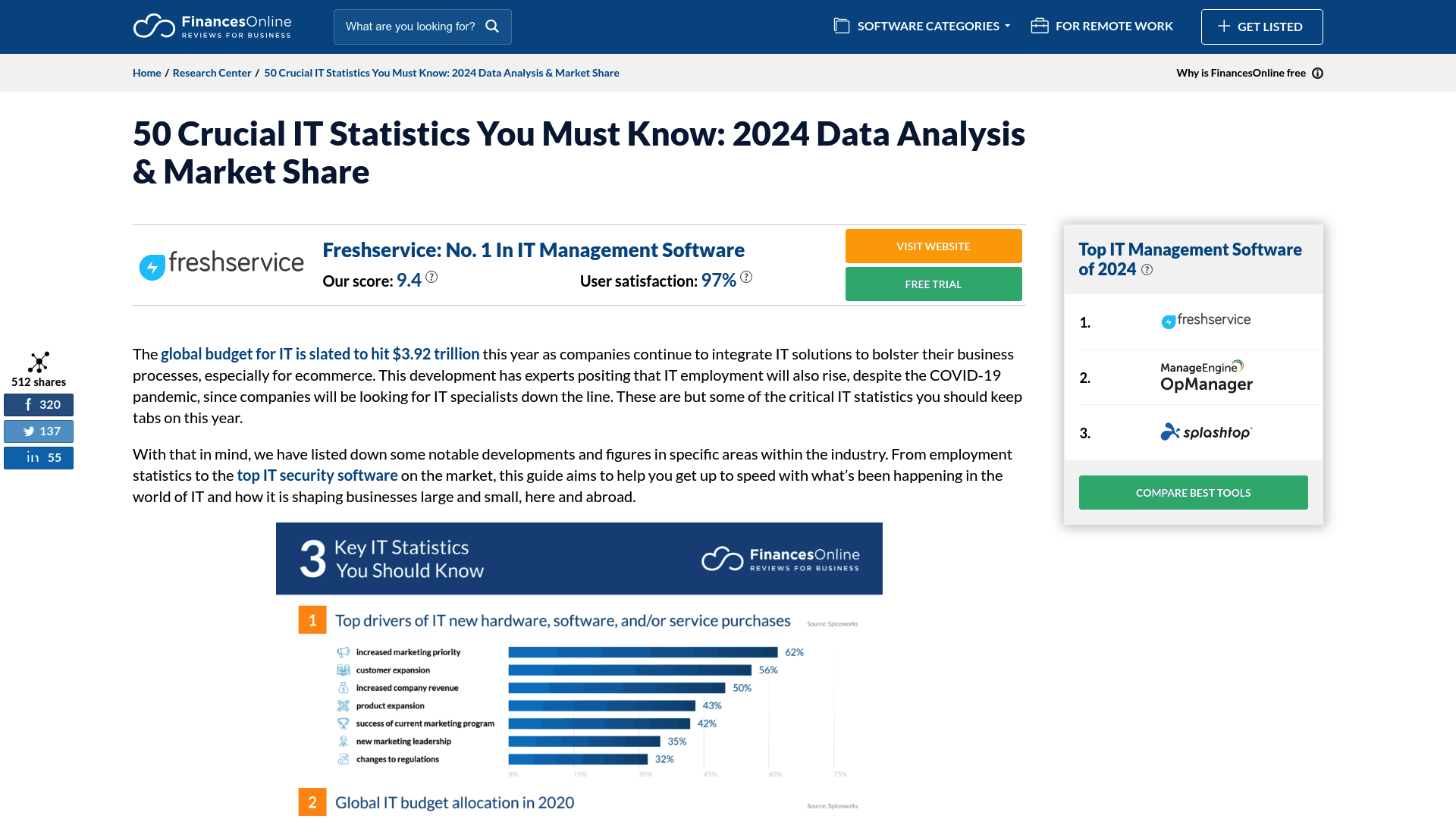
13. Bionic’s Business Energy Usage Statistics Page

The “Average Energy Consumption for Different UK Businesses” page by Bionic is another example of a stats page that hasn’t earned hundreds of links, but one that doesn’t need to.
The links it’s earned are so incredibly relevant, including from other ‘competitors’ who compete on the SERPs for the same topics.
In fact, what we see here is that when you create something that’s so useful, even your competitors will link to it (sometimes).
And it’s niche. You can’t get much more relevant to Bionic than stats on business energy consumption stats.
What makes this page effective is its niche focus and practical value. Business energy consumption is a subject that directly impacts costs, sustainability, and operational decisions, making it highly linkable for those writing about the key topics, even when they’re competitors.
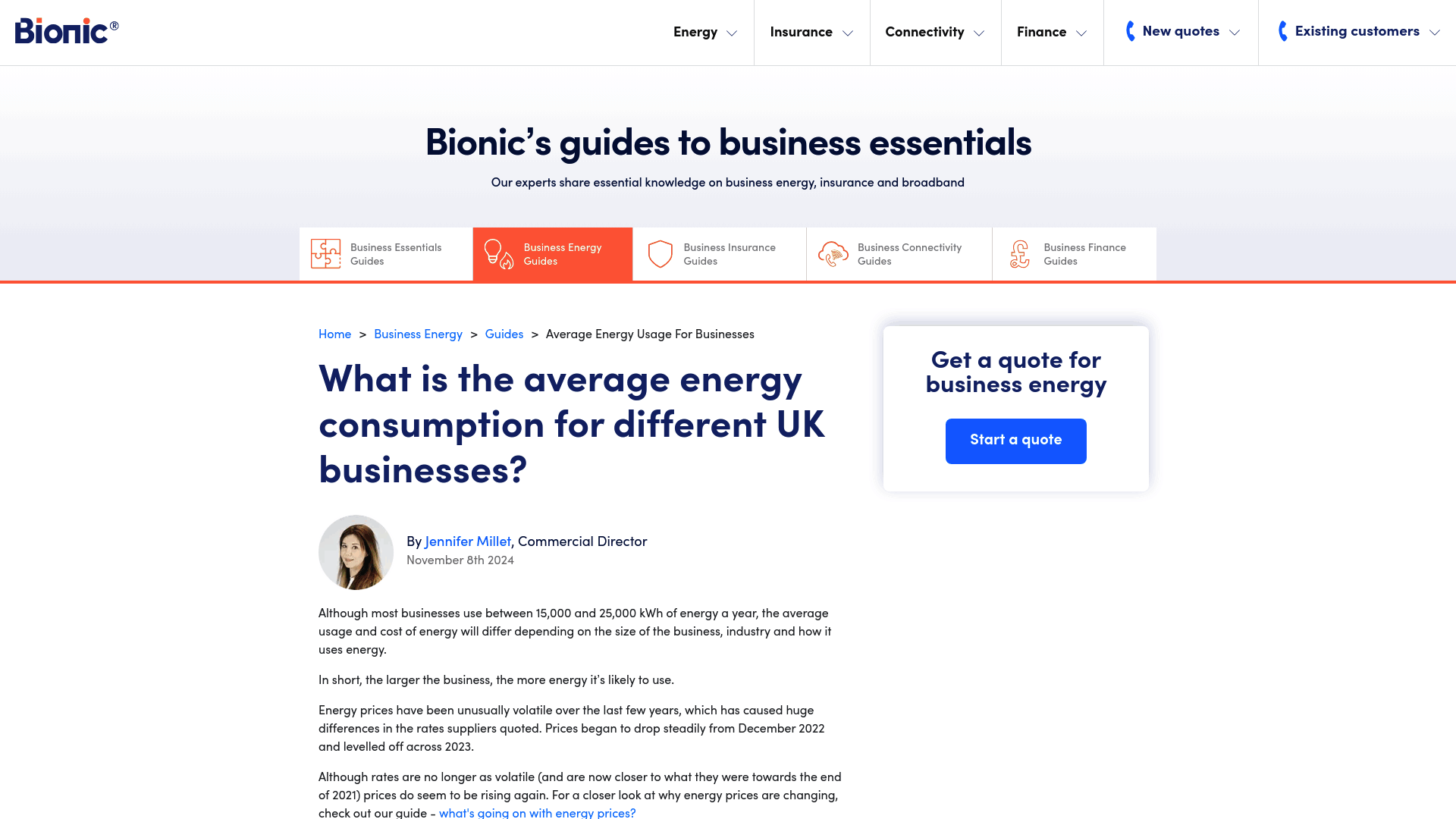
14. Horticulture’s Gardening Statistics Page

What the “UK Gardening Statistics for 2024” page by Horticulture Magazine teaches us that others don’t necessarily is how impactful it can be to include ‘headline stats’ at the top of the page.
Think of it from a journalist or bloggers’ perspective.
They’re busy people. They want stats fast. So help make that possible.
A simple ‘headline stats’ box can make it so easy for them to find what they want quickly, as well as giving more context for those who are looking for it.

15. PureGym’s Gym Statistics Page

The “UK Fitness Report – 2023/24 Gym Statistics” by PureGym isn’t just a stats page.
It’s based on a wider survey and report that the gym group runs, but one that’s set up in a way that works amazingly as a link-earning stats page.
Do I think this has been proactively promoted? Yes, without a doubt.
But it’s continued to earn links on an ongoing basis, backing up the importance of combining proactive outreach with stats pages to kickstart the process of organically earning links.
What also sets this page apart is how it leverages PureGym’s position in the industry to offer data that feels authoritative but still highly approachable to everyday readers.
One standout element of this page is its subtle connection to PureGym’s brand mission. While it’s designed to earn organic links as a trusted resource, it also positions PureGym as an expert in the fitness space. It’s a great example of a page that achieves both SEO and brand-building goals by offering high-value content with utility for content creators.
For those looking to replicate this tactic, it’s a reminder that a statistics page doesn’t have to be boring or removed from your brand mission—it can reflect your brand’s personality and align with its purpose while still earning links organically.
PureGym’s execution shows that combining expertise, data and storytelling makes for a link-worthy asset that can drive long-term results.

Creating Statistics Pages That Earn Links and Authority
Statistics pages are more than just a collection of numbers on a page—they’re powerful assets that, when executed well, can consistently earn links, boost your authority, and drive organic growth.
As we’ve seen from the examples I shared, the magic lies in creating content that’s genuinely valuable to content creators like journalists and bloggers.
What sets these pages apart isn’t flashy design or overly complex execution—it’s relevance, utility, and a focus on topics that people care about.
Whether it’s niche insights on energy usage, evergreen topics like fitness trends, or hot issues like plastic pollution, the best-performing statistics pages align with the demand for information to be cited in other people’s content while providing something unique or comprehensive.
If you’re planning to create a statistics page, remember these key takeaways:
- Choose a Relevant Topic: Focus on a subject that aligns with your expertise and has consistent demand.
- Deliver Value: Provide well-structured, highly useful content that’s easy to cite and reference.
- Think Long-Term: A great statistics page should be evergreen, continuing to earn links well after its launch.
- Kickstart the Process of Ranking: Combine organic potential with proactive outreach to help your page gain early traction.
Whether you’re building your first statistics page or refining your strategy, the opportunity is there to create an asset that not only ranks but also becomes an indispensable resource in your niche.
Need help turning this tactic into a reality?
Let our team guide you in ideating, creating, and promoting a statistics page that delivers results.
The links won’t build themselves—but with the right approach, they might just feel like they do.



